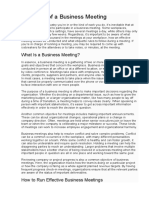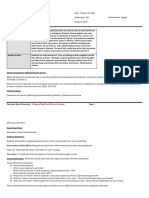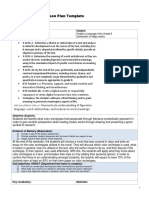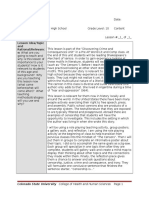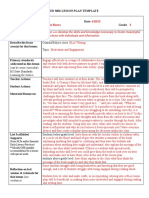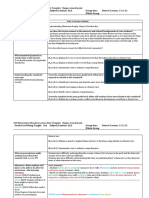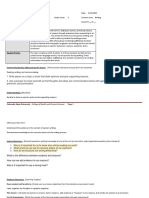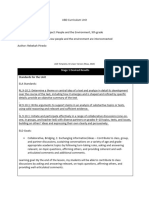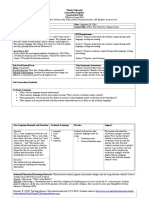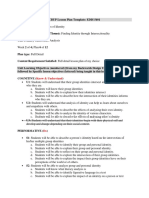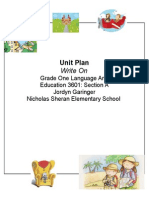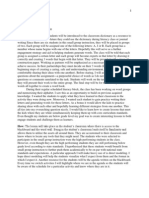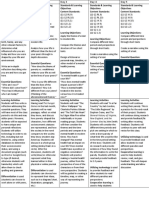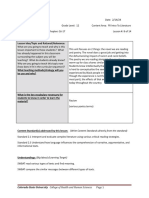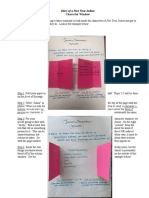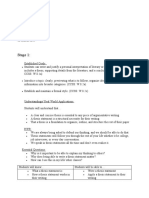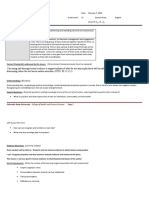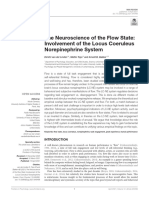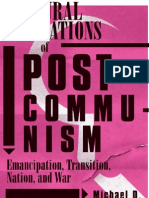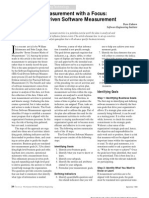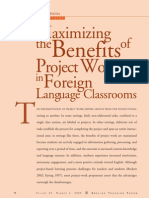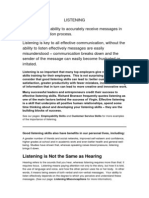Professional Documents
Culture Documents
CEP Lesson Plan Form: Lesson Idea/Topic and Rationale/Relevance
CEP Lesson Plan Form: Lesson Idea/Topic and Rationale/Relevance
Uploaded by
api-502980552Original Description:
Original Title
Copyright
Available Formats
Share this document
Did you find this document useful?
Is this content inappropriate?
Report this DocumentCopyright:
Available Formats
CEP Lesson Plan Form: Lesson Idea/Topic and Rationale/Relevance
CEP Lesson Plan Form: Lesson Idea/Topic and Rationale/Relevance
Uploaded by
api-502980552Copyright:
Available Formats
CEP Lesson Plan Form
Teacher: Danielle Parker Date: December 1, 2020
School: Rocky Mountain High School Grade Level: 12 Content Area: Language Arts
Title: Reader’s Theatre: Audre Lorde Lesson #:3 of 10
Lesson Idea/Topic and In this lesson, students will continue to be exposed to poetry in relation to
Rationale/Relevance: identity, but this lesson serves as a deep dive. In order to understand how
identity informs and influences a writer’s work, students need a full picture.
Through this lesson, we will take an extensive look at the life and work of
Audre Lorde. As a result of this lesson, students will make hands on
connections between a poet’s life and identity to their work. As a result,
students will be able to strengthen their original pieces by following this
same process and infuse their work with their identity.
Student Profile: This class is composed of roughly thirty students. The students have mixed
abilities and strengths, and are predominantly White. All students are high
school seniors.
Content Standard(s) addressed by this lesson:
Determine two or more themes or central ideas of a text and analyze their development over the course of the text,
including how they interact and build on one another to produce a complex account; provide an objective summary
of the text. (CCSS: RL.11-12.2)
Cite strong and thorough textual evidence to support analysis of what the text says explicitly as well as inferences
drawn from the text, including determining where the text leaves matters uncertain. (CCSS: RL.11-12.1)
Understandings: (Big Ideas)
Through poetry, we can explore our own identity and the identity of others
Poetry is a powerful vehicle for narrative
Colorado State University College of Health and Human Sciences Page 1
CEP Lesson Plan Form
Inquiry Questions: (Essential questions relating knowledge at end of the unit of instruction, select applicable questions from standard)
How can we use poetry to highlight our identities and tell our stories?
What does the poetry of others tell us about their identities?
What is the value of exploring the identity of others?
Evidence Outcomes: (Learning Targets)
Every student will be able to: analyze a poet’s life and draw connections between their identity and experiences to their work.
I can: use what I have learned about a writer’s life and identity to tease out instances in their work where their identity and experiences are referenced or have
been interweaved.
This means: that by the end of class I can identify an instance in Audre Lorde’s work where she presents a piece of her identity and life experience in her work,
select one move that she made that impacted me as a reader, and use it in a quickwrite piece of my own that will be used as an exit ticket.
List of Assessments: (Write the number of the learning targets associated with each assessment)
Formative:
Analyzing verbal and non-verbal cues to see if students are engaged and understand what is going on.
Walking around the room and listening to conversations students have with fellow classmates.
Assessing quickwrites gathered from students as an exit ticket
Summative:
Build-your-own anthology
Colorado State University College of Health and Human Sciences Page 2
CEP Lesson Plan Form
Planned Lesson Activities
Name and Purpose of Lesson Reader’s Theatre: Audre Lorde Edition. This student provides a deep dive into the life of
activist, author, and poet Audre Lorde. In this lesson, we will look at her identity and
experiences and make connections to her work. This process will serve as a foundation
for students that they can come back to and pull inspiration from when they are writing
their original pieces.
Co-Teaching Which model(s) will be used?
Will co-teaching models be utilized in this lesson? N/A
Yes ___ No ___ Why did you choose this model(s) and what are the teachers’ roles?
N/A
Approx. Time and Materials Approximate Time: 90 minutes
Materials: Students will need their interactive notebook, a writing utensil of their choice,
and copies of Audre Lorde poems that will be provided by me.
Anticipatory Set The strategy I intend to use is: Students will walk in, grab their interactive notebooks, and
we will watch Dr. Martin Luther King’s “Proud to be Maladjusted” speech circa 1963. In
response to this video, students will engage in a quickwrite where they talk about what
they are maladjusted to. After this, they will collaborate with their small writing groups
and share ideas. (20 minutes)
I am using this strategy here because: As we are talking about identity, I want to give
students several different ways of looking into identity. What you don’t believe in or are
against is just as much of your identity as what you are for and believe in. This also serves
as a great segue into deep diving into the work of Audre Lorde because so much of her
writing is centered around what she doesn’t believe in and what needs to change.
Procedures The strategy I intend to use is: A mixture between whole class, small group, and
individual work.
I am using this strategy here because: This gives students the opportunity to formulate
their own ideas, but also to collaborate, broaden their ideas with small groups, and
debrief as a class.
Teacher Actions Student Actions Data Collected
Colorado State University College of Health and Human Sciences Page 3
CEP Lesson Plan Form
1. I will walk around 1. Students will 1. This tells me more
to listen in on group collaborate with about who my
conversations, their writing groups students are, their
facilitate as about what they interests, and
needed, and get my are maladjusted to. passions.
sheet of butcher (5 minutes) 2. This informs me of
paper ready to 2. We will come class interests and
make an anchor together as a whole passions. It also
chart. class and students informs me if they
2. As students are will state things understood what
talking, I will write they and their the speech is about.
down on the group members are 3. This informs me if
anchor chart what maladjusted to. (5 students are
we are all minutes) understanding the
maladjusted to. 3. Students will watch speech and digging
This anchor chart this speech by into Audre Lorde’s
will be posted on Audre Lorde, and words.
the wall in the make notes of 4. This will inform me
classroom to serve different facets of if students are
as a source of her identity in their understanding the
inspiration and a interactive poems and are
seed for their notebook under making ties
original pieces if their mentor text between her work
they get stuck. section. (5 minutes) and her identity.
3. I will cue up the 4. Students will be 5. This lets me know
speech and walk divided into four what students
around to see what groups, each pulled from their
students are writing receiving a different poems and if I need
down as the speech poem by Audre to touch on any
plays. Lorde. Students will points during whole
4. I will divide read the poem class debrief.
students into four individually, 6. This informs we
groups, pass out annotate it and what students got
the poems, and let mine it for from today’s study,
them read. After instances of her if they need or
Colorado State University College of Health and Human Sciences Page 4
CEP Lesson Plan Form
this, I will be identity and would like any
walking around to experiences, and more resources,
listen in on then come together and if I need to
conversations, as a group and reteach or touch on
answer questions, discuss. (15 anything next time.
and facilitate as minutes). 7. This exit ticket
needed. 5. We will then jigsaw informs me of what
5. I will pull everyone and students will be students pulled
back together, put into new from Audre Lorde’s
initiate the jigsaw, groups. Each poems, if they were
and guide students member of the able to make
to their new group will have had connections, and if
groups. I will then a different poem they are able to
walk around, listen and will teach the translate what they
in on conversations, other members learned from her
and facilitate as about it. (20 into their own
needed. Toward minutes) work.
the end, I will 6. We will debrief as a
prepare my anchor class and discuss
chart for Audre what we’ve learned
Lorde for after about Audre Lorde,
jigsaw. her work, and her
6. I will pull students identity. (10
back together, and minutes)
we will debrief as a 7. Students will use a
class. I will take move they took
note of what away from Audre
students are saying Lorde and
and add it to our quickwrite an
Audre Lorde anchor impromptu poem
chart which will about their identity
also be posted in using that move in
the classroom and their interactive
serve as an notebooks as an
inspiration for exit ticket. They will
Colorado State University College of Health and Human Sciences Page 5
CEP Lesson Plan Form
students. also need to
7. I will wrap up the underline the move
discussion, guide and tell me about
students back to it. (10 minutes)
their seats, and give
them time to write.
Closure The strategy I intend to use is: a quickwrite that serves as an exit ticket.
I am using this strategy here because: It gives me insight as to what students took away
from this study and allows them to debrief their thoughts on their own.
Differentiation Content Process Product Environment
Modifications:
For the final
quickwrite, I
gave students
complete
choice in what
move they
chose, the style
they wanted to
write their
poem, and
what poem
they wanted to
choose from.
Extensions: For an
extension to
the study of
Audre Lorde, I
would have
students look
into the
cultural and
societal
Colorado State University College of Health and Human Sciences Page 6
CEP Lesson Plan Form
attitudes of the
time. This
means any bog
events that
happened,
social
movements,
etc. Students
could then use
this
information to
further inform
external
impacts Audre
Lorde was
influenced by.
Assessment
Formative:
Analyzing verbal and non-verbal cues to see if students are engaged and
understand what is going on.
Walking around the room and listening to conversations students have
with fellow classmates.
Assessing quickwrites gathered from students as an exit ticket
Summative:
Build-your-own anthology
Colorado State University College of Health and Human Sciences Page 7
CEP Lesson Plan Form
Post Lesson Reflection
1. To what extent were lesson objectives achieved? (Utilize assessment data to justify
your level of achievement)
2. What changes, omissions, or additions to the lesson would you make if you were to
teach again?
3. What do you envision for the next lesson? (Continued practice, reteach content, etc.)
4. If you used co-teaching, would you use the same co-teaching strategy for this lesson
if you were to teach it again? Were there additional co-teaching strategies used
during the lesson not planned for initially? Please explain.
Colorado State University College of Health and Human Sciences Page 8
CEP Lesson Plan Form
Lesson Plan Appendix
Lesson Idea/Topic and Rational/Relevance: What are you going to teach and why is this lesson of
importance to your students? How is it relevant to students of this age and background?
Student Profile: Write a narrative about your learners. What are their special needs? Exceptionalities?
Giftedness? Alternative ways of learning? Maturity? Engagement? Motivation?
Name and Purpose of Lesson: Should be a creative title for you and the students to associate with the
activity. Think of the purpose as the mini-rationale for what you are trying to accomplish through this
lesson.
Co-Teaching: Models – One teach/One observe, One teach/One assist, Station teaching, Parallel
teaching, Alternative/Differentiated/Supplemental teaching, Team teaching.
Approx. Time and Materials: How long do you expect the activity to last and what materials will you
need?
Anticipatory Set: The “hook” to grab students’ attention. These are actions and statements by the
teacher to relate the experiences of the students to the objectives of the lesson, To put students into a
receptive frame of mind.
To focus student attention on the lesson.
To create an organizing framework for the ideas, principles, or information that is to follow
(advanced organizers)
An anticipatory set is used any time a different activity or new concept is to be introduced.
Procedures: Include a play-by-play account of what students and teacher will do from the minute they
arrive to the minute they leave your classroom. Indicate the length of each segment of the lesson. List
actual minutes.
Indicate whether each is:
teacher input
modeling
questioning strategies
guided/unguided:
o whole-class practice
o group practice
o individual practice
check for understanding
other
Closure: Those actions or statements by a teacher that are designed to bring a lesson presentation to an
appropriate conclusion. Used to help students bring things together in their own minds, to make sense
out of what has just been taught. “Any Questions? No. OK, let’s move on” is not closure. Closure is used:
To cue students to the fact that they have arrived at an important point in the lesson or the end
of a lesson.
To help organize student learning
To help form a coherent picture and to consolidate.
Colorado State University College of Health and Human Sciences Page 9
CEP Lesson Plan Form
Differentiation: To modify: If the activity is too advanced for a child, how will you modify it so that they
can be successful? To extend: If the activity is too easy for a child, how will you extend it to develop
their emerging skills? What observational assessment data did you collect to support differentiated
instruction?
Assessment (data analysis): How will you know if students met the learning targets? Write a description
of what you were looking for in each assessment. How do you anticipate assessment data will inform
your instruction?
Colorado State University College of Health and Human Sciences Page 10
You might also like
- Molecules of EmotionsDocument4 pagesMolecules of Emotionsmeliancurtean4659100% (3)
- Lesson Plan Rosewood MassacreDocument7 pagesLesson Plan Rosewood Massacreapi-314993838No ratings yet
- Definition of A Business MeetingDocument4 pagesDefinition of A Business MeetingBig Life0% (1)
- Preparing To TeachDocument251 pagesPreparing To TeachacajahuaringaNo ratings yet
- How Temporal Focus Shapes The Influence of Executive Compensation On Risk TakingDocument29 pagesHow Temporal Focus Shapes The Influence of Executive Compensation On Risk TakingFatikchhari USONo ratings yet
- CEP Lesson Plan Form: (Write Content Standards Directly From The Standard)Document8 pagesCEP Lesson Plan Form: (Write Content Standards Directly From The Standard)api-357419171No ratings yet
- Cep Lesson Plan and Reflection - Brooklyn ReyesDocument10 pagesCep Lesson Plan and Reflection - Brooklyn Reyesapi-549599661No ratings yet
- Rationale Theory: Common Misconceptions/ DifficultiesDocument4 pagesRationale Theory: Common Misconceptions/ Difficultiesapi-356513456No ratings yet
- Day 1 5 Lesson PlanDocument5 pagesDay 1 5 Lesson Planapi-510196808No ratings yet
- Minor JDocument6 pagesMinor Japi-341972597No ratings yet
- Unit Plan Writing NarrativeDocument17 pagesUnit Plan Writing Narrativeapi-288700696No ratings yet
- Guided Reading GroupsDocument3 pagesGuided Reading Groupsapi-594522478No ratings yet
- Direct Instruction Lesson Plan TemplateDocument7 pagesDirect Instruction Lesson Plan Templateapi-403795899No ratings yet
- Observation Number 2Document3 pagesObservation Number 2api-357419171No ratings yet
- Lesson Plan Template Grade/Content Area Lesson Title State StandardsDocument4 pagesLesson Plan Template Grade/Content Area Lesson Title State Standardsapi-404244796No ratings yet
- Lesson Idea/Topic and Rational/Relevanc E: What Are You: CEP Lesson Plan FormDocument8 pagesLesson Idea/Topic and Rational/Relevanc E: What Are You: CEP Lesson Plan Formapi-353478397No ratings yet
- Grimesey Introweekmap FinalDocument4 pagesGrimesey Introweekmap Finalapi-341187427No ratings yet
- Gang Mentality Lesson PlanDocument5 pagesGang Mentality Lesson Planapi-316592134No ratings yet
- Lesson PlanDocument7 pagesLesson Planapi-651343326No ratings yet
- Us Formal 2Document7 pagesUs Formal 2api-576899685No ratings yet
- Lesson Plan 3 - Socratic Seminar ModelDocument6 pagesLesson Plan 3 - Socratic Seminar Modelapi-498931519No ratings yet
- Cep Lesson Plan 2Document9 pagesCep Lesson Plan 2api-690650522No ratings yet
- Cep Lesson Plan Quote IntroductionsDocument10 pagesCep Lesson Plan Quote Introductionsapi-643118051No ratings yet
- Common Core Lesson PlannerDocument3 pagesCommon Core Lesson Plannerapi-419135285No ratings yet
- Unit 4 Lesson 2 Lesson PlanDocument1 pageUnit 4 Lesson 2 Lesson Planapi-572970422No ratings yet
- Cep Lesson Plan 2-23Document10 pagesCep Lesson Plan 2-23api-630895186No ratings yet
- Poetry Unit: Lesson Idea/Topic and Rational/RelevanceDocument19 pagesPoetry Unit: Lesson Idea/Topic and Rational/Relevanceapi-377302210No ratings yet
- Inquiry Lesson PlanDocument12 pagesInquiry Lesson Planapi-5503562950% (1)
- Assessment Tool Overview: Assessme NT Tool Brief DescriptionDocument5 pagesAssessment Tool Overview: Assessme NT Tool Brief Descriptionapi-359979131No ratings yet
- English Lesson Plan 2Document4 pagesEnglish Lesson Plan 2api-518990010No ratings yet
- Skills of The Discipline. These Represent The Skills That Will Be Assessed.)Document4 pagesSkills of The Discipline. These Represent The Skills That Will Be Assessed.)api-405546093No ratings yet
- Headly El Dador 1Document4 pagesHeadly El Dador 1api-210163638No ratings yet
- Lesson Plan 3Document8 pagesLesson Plan 3api-385481283No ratings yet
- Spring Shellsea Melaratep Elementary Lesson Plan Abridged Original 1 1Document5 pagesSpring Shellsea Melaratep Elementary Lesson Plan Abridged Original 1 1api-667812603No ratings yet
- Kami Export - Unit People and The Environment 1Document12 pagesKami Export - Unit People and The Environment 1api-711296025No ratings yet
- Tws Lesson PlanDocument8 pagesTws Lesson Planapi-257584473No ratings yet
- Unit: MSTEP Practice CCSS or State Standards: Lesson Title: Monthly MSTEP Practice Grade/Period: 7A &7BDocument4 pagesUnit: MSTEP Practice CCSS or State Standards: Lesson Title: Monthly MSTEP Practice Grade/Period: 7A &7Bapi-318157741No ratings yet
- Richard Cory Co-Plan Lesson PlanDocument4 pagesRichard Cory Co-Plan Lesson Planapi-534097479No ratings yet
- Benchmark Lesson Week 4Document4 pagesBenchmark Lesson Week 4api-448690566No ratings yet
- Week 3Document28 pagesWeek 3Belizean BuayNo ratings yet
- Lesson Plan Template: Criteria For Each Aspect of The LessonDocument6 pagesLesson Plan Template: Criteria For Each Aspect of The Lessonapi-582444706No ratings yet
- RDG Lesson Plan - HomophonesDocument12 pagesRDG Lesson Plan - Homophonesapi-265197521No ratings yet
- Best Lesson 2 and DataDocument8 pagesBest Lesson 2 and Dataapi-486185691No ratings yet
- Foggy FigureDocument6 pagesFoggy Figureapi-281523380No ratings yet
- Gcu Elm-590 Week 8 Lesson PlanDocument2 pagesGcu Elm-590 Week 8 Lesson Planapi-539839605No ratings yet
- Constructivist UnitDocument7 pagesConstructivist Unitapi-358655610No ratings yet
- CT o 3 Lesson PlanDocument4 pagesCT o 3 Lesson Planapi-298704503No ratings yet
- Vibes Writinginstruction March14Document15 pagesVibes Writinginstruction March14api-403354017No ratings yet
- Cbup LP6Document8 pagesCbup LP6Jane PatrickNo ratings yet
- Lesson Plan Template: Essential QuestionDocument6 pagesLesson Plan Template: Essential Questionapi-531359505No ratings yet
- Ed 215 Lesson Plan 2-2Document5 pagesEd 215 Lesson Plan 2-2api-296442187No ratings yet
- Lesson Plan Template: Criteria For Each Aspect of The LessonDocument4 pagesLesson Plan Template: Criteria For Each Aspect of The LessonMadelyn JohnstonNo ratings yet
- Spe 417 Signature Assignment Lesson PlanDocument14 pagesSpe 417 Signature Assignment Lesson Planapi-533098905No ratings yet
- Itl 520 Learning MapDocument7 pagesItl 520 Learning Mapapi-535727969No ratings yet
- 3 4 24Document7 pages3 4 24api-707646511No ratings yet
- CT Unit PlanDocument11 pagesCT Unit Planapi-302777648No ratings yet
- Writing Process Lesson Plans - Kyle Amanda MiguelDocument13 pagesWriting Process Lesson Plans - Kyle Amanda Miguelapi-489871389No ratings yet
- Direct Instruction Lesson PlanDocument5 pagesDirect Instruction Lesson Planapi-488382118No ratings yet
- Nancy Levit EditsDocument5 pagesNancy Levit Editsty70001No ratings yet
- Sheila The Brave Lesson Plan Day1Document7 pagesSheila The Brave Lesson Plan Day1api-301531754No ratings yet
- Project Narrative CalendarDocument6 pagesProject Narrative Calendarapi-532709560No ratings yet
- CEP Lesson Plan Form: Colorado State University College of Health and Human SciencesDocument7 pagesCEP Lesson Plan Form: Colorado State University College of Health and Human Sciencesapi-707646511No ratings yet
- (Write Content Standards Directly From The Standard) : CEP Lesson Plan FormDocument8 pages(Write Content Standards Directly From The Standard) : CEP Lesson Plan Formapi-425097847No ratings yet
- Creating Activities for Different Learner Types: A Guide for ELT Teachers, Trainers, and WritersFrom EverandCreating Activities for Different Learner Types: A Guide for ELT Teachers, Trainers, and WritersRating: 5 out of 5 stars5/5 (1)
- Cep DispositionsDocument6 pagesCep Dispositionsapi-502980552No ratings yet
- Character WindowDocument2 pagesCharacter Windowapi-502980552No ratings yet
- Ubd Lesson Plan 2Document4 pagesUbd Lesson Plan 2api-502980552No ratings yet
- Classroom ContractDocument1 pageClassroom Contractapi-502980552No ratings yet
- Let'S Get Wordy: IdeasDocument1 pageLet'S Get Wordy: Ideasapi-502980552No ratings yet
- Ubd Lesson Plan 1Document4 pagesUbd Lesson Plan 1api-502980552No ratings yet
- Cep Lesson Plan TemplateDocument8 pagesCep Lesson Plan Templateapi-502980552No ratings yet
- CEP Lesson Plan Form: Colorado State University College of Health and Human SciencesDocument6 pagesCEP Lesson Plan Form: Colorado State University College of Health and Human Sciencesapi-502980552No ratings yet
- Classroom Management PlanDocument7 pagesClassroom Management Planapi-502980552No ratings yet
- Unit CalendarDocument3 pagesUnit Calendarapi-502980552No ratings yet
- Aida Sales Technique: Incall InternationalDocument7 pagesAida Sales Technique: Incall InternationalSonia SussmannNo ratings yet
- Organizations As Obstacles To OrganizingDocument31 pagesOrganizations As Obstacles To OrganizinghmarroNo ratings yet
- The Science of Flow StateDocument6 pagesThe Science of Flow Statesergio.siracusaNo ratings yet
- Northern and Rural Social Work PracticeDocument368 pagesNorthern and Rural Social Work PracticeGoogIeNo ratings yet
- SEL 3 Signature Practices Playbook 10.21.19Document65 pagesSEL 3 Signature Practices Playbook 10.21.19Domingo Juan de LeónNo ratings yet
- Attention and Sensory Connection: WorkbookDocument15 pagesAttention and Sensory Connection: Workbookanon_82154430100% (5)
- Module 3 Managing Challenging BehavioursDocument21 pagesModule 3 Managing Challenging BehavioursYouth in Science and Business FoundationNo ratings yet
- Solomon 2Document16 pagesSolomon 2santirianingrumNo ratings yet
- Design Approaches and Tools in Education and TrainingDocument296 pagesDesign Approaches and Tools in Education and Trainingmutia febri mouliNo ratings yet
- Awakening and Sleep-Wake Cycle Across DevelopmentDocument290 pagesAwakening and Sleep-Wake Cycle Across DevelopmentHaning Tyas Cahya PratamaNo ratings yet
- Essays On Virginia WoolfDocument6 pagesEssays On Virginia WoolfAngela P.No ratings yet
- Of 2 Minds - How Fast and Slow Thinking Shape Perception and Choice (Excerpt) - Scientific AmericanDocument15 pagesOf 2 Minds - How Fast and Slow Thinking Shape Perception and Choice (Excerpt) - Scientific AmericanFlaMe Welcome ツNo ratings yet
- Ibrahim Raja August 2022 Theraplay ReportDocument6 pagesIbrahim Raja August 2022 Theraplay Reportfatma522No ratings yet
- The Milan Approach - Roots and EvolutionDocument4 pagesThe Milan Approach - Roots and EvolutionVivir Sin ViolenciaNo ratings yet
- Cultural Formations of Post CommunismDocument381 pagesCultural Formations of Post Communismhegalijaner100% (1)
- Chapter 12 ReflectionDocument1 pageChapter 12 ReflectionMae Althea TidalgoNo ratings yet
- Macrae, C. BodenhausenDocument17 pagesMacrae, C. BodenhausenSimone AraujoNo ratings yet
- Measurement With A Focus: Goal-Driven Software MeasurementDocument4 pagesMeasurement With A Focus: Goal-Driven Software MeasurementLydia LeeNo ratings yet
- Consumer Behaviour - ShareDocument61 pagesConsumer Behaviour - ShareVijay KumarNo ratings yet
- The French Revolution in Cultural HistoriesDocument11 pagesThe French Revolution in Cultural HistoriesNitin VermaNo ratings yet
- MAASDocument2 pagesMAASLuke SetyoNo ratings yet
- Maximizing The Benefits of Project Work in The Foreign Language ClassroomDocument12 pagesMaximizing The Benefits of Project Work in The Foreign Language Classroomkimjhowe100% (4)
- Researching Others: Epistemology, Experience, Standpoints and ParticipationDocument19 pagesResearching Others: Epistemology, Experience, Standpoints and ParticipationLoredana CernatNo ratings yet
- The Power of PresenceDocument10 pagesThe Power of PresenceheribertoNo ratings yet
- ListeningDocument5 pagesListeningDylan LiewNo ratings yet
- Research Philosophy Statement Jennifer ManiDocument3 pagesResearch Philosophy Statement Jennifer Maniapi-488928290No ratings yet


